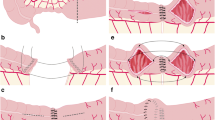Abstract
Method. Between 10/1997 and 2/2000 we treated eight patients (∼66,5 y, 31–92 y, 5 male, 3 female). These cases were analyzed retrospectively.
Results. In one case the the perforation was located in the cervical part, in three cases in the intermediate part, and in four cases in the distal part ofesophagus. In seven cases the perforation was caused by endoscopic and one acid burn in suicidal intention. Surgical treatment was performed in seven cases (87,5%), five of them with primary suture, two with primary esophageal resection. The mortality rate was 50%. There was no insufficieny of the suture, but two patients died because of pulmonal complications, one patient with known hepatic cirrhosis (Child C) because of an uncontrollable bleeding of his fundus and esophageal complications 5 days after successful surgical treatment, and one patient because of fulminant sepsis after dislocation of an enteral catheter. Three of the patients were operated within 12 hours after perforation, seven of them were operated within less than 24 hours.
Conclusions. Surgical treatment of esophageal perforation within 24 hours after perforation shows good results. The outcome of the treatment depends on whether there are postoperativ pulmonal complications and concomitant diseases. Enteral nutrition should be avoided in cases of primary esophageal resection to facilitate the surgical reconstruction at the second operation.
Zusammenfassung
Hintergrund. Die Ösophagusperforation ist ein akutes, lebensbedrohliches Krankheitsbild mit einer hohen Letalitäts- und Komplikationsrate, das ein differenziertes diagnostisches und therapeutisches Prozedere erfordert.
Methode. Acht Ösophagusperforationen (10/1997–2/2000; 5 Männer, 3Frauen; ∼66,5 Jahre), wurden retrospektiv analysiert.
Ergebnisse. Alle Perforationen wurden radiologisch mit wasserlöslichem Kontrastmittel oder endoskopisch nachgewiesen. Häufigste Ursache der Verletzungen (7/8 Patienten) waren endoskopische Untersuchungen oder Behandlungen. In 7 von 8 Fällen haben wir uns für die Operation als Therapie der Wahl entschieden (5 Übernähungen, 2 primäre Ösophagusresektionen mit und ohne Gastrektomie). In einem Fall wurde eine ältere Perforation durch einen gecoateten Stent in Verbindung mit Fibrinkleber erfolgreich behandelt. Insgesamt hatten wir eine Letalität von 50%, die nicht durch eine Nahtinsuffizienz bedingt, sondern Folge pulmonaler Komplikationen (n=2), der Begleiterkrankung (Leberzirrhose Child C) oder Dislokation eines jejunalen Ernährungskatheters war.
Schlussfolgerungen. Das chirurgisches Vorgehen ist bei frischen Perforationen die Therapie der Wahl. Das Behandlungsergebnis wird von den begleitenden Komplikationen bestimmt. Enterale Ernährungskatheter sollten im Hinblick auf geplante sekundäre Rekonstruktionen nicht verwendet werden.
Similar content being viewed by others
Author information
Authors and Affiliations
Rights and permissions
About this article
Cite this article
Strohm, P., Müller, C., Jonas, J. et al. Ösophagusperforation Entstehung, Diagnostik, Therapie. Chirurg 73, 217–222 (2002). https://doi.org/10.1007/s00104-001-0405-1
Published:
Issue Date:
DOI: https://doi.org/10.1007/s00104-001-0405-1




